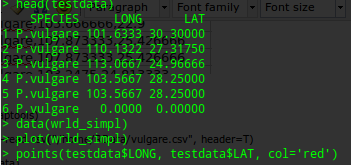看看这些有意思的文章吧!
How many taxonomists are there?
Essential Reading.
There is only a limited number of papers and reports that give
information on the status and development of the taxonomic capacities,
especially the human capacities. Our working database with 350
contributions on taxonomy, DNA-Taxonomy, Barcoding and cases studies
will soon be online. The data base include abstracts and links to online
sources.
The whole issue 1444 of volume 359 of the “Philosophical
Transactions: Biological
Sciences”
is devoted to taxonomy and its sattus and development.
Here is an alphabetic listing of what I found (see also the references
there-in):
A
Alberch P (1993) Museums, Collections and Biodiversity Inventories.
Trends in Ecology and Evolution 8(10):372-375.
B
Bisby FA, Shimura J, Ruggiero M, Edwards J, Häuser C (2002) Taxonomy, at
the click of a mouse. Nature 418:367.
Blackwelder RE & Blackwelder RM (1961) Directory of Zoological
Taxonomists of the World. Southern Illionois University Press,
Carbondale, Ill. (No ISBN no. available at that time but Library of
Congress no. 61-15306 )
C
Cribb TH (2004) Living on the edge: parasite taxonomy in Australia.
International Journal for Parasitology 34: (2)117-123.
D
Dickson D (1993) Britain funds taxonomy studies. Nature 362:383.
E
Edwards SR, David GM, Nerlin LI (1985) The Systematics Community.
Association of Systematics Collections c/o Museum of Natural History,
University of Kansas, Lawrence, Kansas 66045. Prepared for the NSF. ISBN
0-942924-12-6
G
Gaston KJ, May RM (1992) Taxonomy of taxonomists. Nature 356:281-283.
Gaston KJ, Mound LA (1993) Taxonomy, hypothesis testing and the
biodiversity crisis. Philosophical Transactions Royal Society, London B
251:139-142. (see link top of page)
Gleich M, Maxeiner D, Miersch M, Nicolay F (2000) Life Counts. 287 pp.
Berlin: Berlin Verlag
Golding SJ, Timberlake J (2003) How Taxonomists Can Bridge the Gap
Between Taxonomy and Conservation Science. Conservation Biology
17(4):1177-1178.
Godfray HCJ (2002) How might more systematics be funded? Antenna
26(1):11-17.
Godfray HCJ, Knapp S (2004) Introduction. Philosophical Transactions:
Biological Sciences 359(1444):559-569. (see link top of page)
Green SV (1998) The taxonomic impediment in orthopteran research and
conservation. Journal of Insect Conservation 2(3-4):151 – 159.
Groombridge, B (ed) (1992) Global Biodiversity: Status of the Earth’s
Living Resources. A Report compiles by the World Conservation Monitoring
Centre. xx, 585 pp.
H
Herbert DG, Smith GF, Hamer ML, Scholtz CH (2001) Taxonomy and
systematics research in South Africa: vital reasearch facing a crisis in
capacity and resources. Link
…
Holden C (1989) Entomologists wane as insects wax. Science 246:754-756.
Hopkins GW, Freckleton RP (2002) Declines in the numbers of amateur and
professional taxonomists: implications for conservation. Animal
Conservation 5(3):245-249.
House of Lords Report on taxonomy and systematic biology from
2001-2002: “What on
Earth”
J
Janzen DH (1993) Taxonomy: Universal and essential infrastructure for
development and management of tropical wildlands biodiversity.
Proceedings of the Norway/UNEP Expert Conference on Biodiversity, O.T.
Sandlund and P. J. Schei (eds.), Trondheim, May, 1993. NINA, Trondheim.
100-113.
K
Klopper RR, Smith GF, Chikuni AC (2001) The Global Taxonomy Initiative:
documenting the biodiversity of Africa. Strelitzia 12:xiii, 1-203.
Konsortium Systematics Agenda 2000 (1996) Agenda Systematik 2000. Kleine
Senckenberg Reihe 21. 55 pp.
Kraus O (1976) Zoological Systematics in Central Europe (Zoologischer
Systematik in Mitteleuropa). sonderbände des Naturwissenschaftlichen
Vereins in Hamburg 1. Verlag Paul Parey, Hamburg und Berlin. ISSN
0301-2697. ASTM-Coden: AVNHAV.
Krell FT (2000) Impact factors aren’t relevant to taxonomy. Nature
405:507-508.
M
May RM (1990) Taxonomy as destiny. Nature 347:129-130.
May RM (1990) How many species? Philosophical Transactions of the Royal
Society B 330:293-304. (see link top of page)
Marioni L, Magalhães C & Marques AC (2005?) PROPOSTAS DE ESTRATÉGIAS E
AÇÕES PARA A CONSOLIDAÇÃO DAS COLEÇÕES ZOOLÓGICAS
BRASILEIRAS.
(In Portugese, DOC download, 300 KB)
Marques AC & Lamas CJE (2005?) Sistemática zoológica no Brasil: estado
da arte, expectativas e sugestões de ações
futuras
(48 pp, PDF download, 330 KB). In Portugese.
N
National Science Foundation NSF (2004) Workshop to Produce a Decadal
Vision for Taxonomy and Natural History Collections. Link
…
PRELIMINARY REPORT OF FIRST GLOBAL TAXONOMY INITIATIVE WORKSHOP IN ASIA.
UNEP/CBD/SBSTTA/9/INF/17.
12 September 2003.
S
Samper C (2004) Taxonomy and environmental policy. Philosophical
Transactions: Biological Sciences 359(1444):721–728. (see link top of
page)
Schminke HK (1996) Naturkundliche Sammlungen – Das vernachlässigte Erbe?
Spektrum der Wissenschaft 1996:116-119.
Schminke HK (1994) Wiederaufbau von Forschung und Lehre in der
Zoosystematik – Eine nationale Aufgabe. Spektrum der Wissenschaft
1994(September):114-116.
Simonetti JA (1997) Biodiversity and a taxonomy of Chilean taxonomists.
Biodiversity and Conservation 6(4):633 – 637.
Suarez AV, Tsutsui ND (2004) The Value of Museum Collections for
Research and Society. BioScience 54(1):66-74.
Systematics Agenda 2000 (1994) Charting the Biosphere. Systematics
Agenda 2000.
W
Wägele JW et al (200X) Methoden, Aufgaben und Leistungsfähigkeit der
modernen Systematik. Kleine Senckenberg Reihe 36:40 pp.
“What on
Earth”
the House of Lords Report on taxonomy and systematic biology from
2001-2002.
Williams J et al (2001) Biodiversity Theme Report. Australia State of
the Environment Report 2001 (Theme Report). ISBN 0 643 06749 3; Link
…
Winston JE, Metzger KL (1998) Trends in taxonomy revealed by the
published literature. BioScience 48:344-346 or 125-128.
Z
Ziegler W et al (1997) Biodiversitätsforschung: Ihre Bedeutung für
Wissenschaft, Anwendung und Ausbildung. Kleine Senckenberg Reihe
26:1-68.
来自:http://www.gti-kontaktstelle.de/taxonomy_Lit.html
 先說明因為
demo 主要功能是 Code Rush > PowerCommand > Power
Tools,因此有重複的功能會優先關掉 Power Tool 的,不過考量到 Code Rush
免費版到底有什麼功能我不知道,因此衝突的部份都會寫出來,有需要的朋友再自行調配使用。
先說明因為
demo 主要功能是 Code Rush > PowerCommand > Power
Tools,因此有重複的功能會優先關掉 Power Tool 的,不過考量到 Code Rush
免費版到底有什麼功能我不知道,因此衝突的部份都會寫出來,有需要的朋友再自行調配使用。 Code
Rush
(官網)預設所有功能都是他,不調整
Code
Rush
(官網)預設所有功能都是他,不調整 PowerCommand
(官網)調整如下:
PowerCommand
(官網)調整如下:
 Power
Tools
(官網)調整如下:
Power
Tools
(官網)調整如下:







